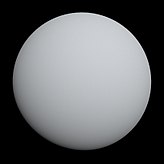K2-155d
| Earth | K2-155d[1] |
|---|---|

|

|
Template:Planetbox begin Template:Planetbox star Template:Planetbox character Template:Planetbox orbit Template:Planetbox discovery Template:Planetbox end
K2-155d is an exoplanet in the K2-155 system. It is probably a rocky super-Earth,[2] It is the outermost of three known planets orbiting K2-155, a bright red dwarf star.[3] It is one of the 15 exoplanets discovered by Japanese astronomer Teruyuki Hirano of the Tokyo Institute of Technology.[4] The evidence for its discovery comes from data gathered during the extended mission of NASA's Kepler spacecraft.[2] Analyses show that it may fall within the habitable zone and may be able to support liquid water.[5][2]
Discovery and observations
K2-155d is one of 15 exoplanets discovered by a team of Japanese astronomers led by Teruyuki Hirano at the Tokyo Institute of Technology.[2] Its discovery is based on data from the K2 mission of NASA’s Kepler spacecraft.[2] The exoplanet has also been observed from ground-based telescopes including the Nordic Optical Telescope (NOT) in La Palma and the Subaru Telescope in Hawaii.[2] Its characteristics were confirmed using speckle imaging and high-dispersion optical spectroscopy.[6] The mass of K2-155d and the brightness of its host star may be measured by future observations from the W. M. Keck Observatory and the James Webb Space Telescope.[6]
K2-155d has also been observed through numerous ground-based telescopes, including the Nordic Optical Telescope in Spain and the Subaru Telescope.[2] The brightness of its host star makes K2-155d a good target for future studies using instruments such as the James Webb Space Telescope.[6]
Characteristics
K2-155d is a super-Earth exoplanet with a radius 1.64 times that of Earth and 0.146 of Jupiter.[1] Its radius lies halfway the similarities of small rocky planets and bigger gas-rich planets.[6][5] Climate models predict that it is located near its star's habitable zone and has an insolation 1.67 ± 0.38 that of Earth.[6] Its physical temperature is estimated to be 289 K, which is 16 degrees Celsius or 61 degrees Fahrenheit.[7] Studies have shown that the planet would maintain a moderate surface temperature if its insolation is smaller than ∼1.5 times that of Earth.[6]
K2-155d is one of three known planets in the system orbiting K2-155, a red dwarf star located 200 light years from Earth.[3] Its parent star has 88% less volume than the Sun.[8] K2-155d orbits its star with a 40.7 day period, but as the planet is tidally locked the same side always faces its sun.[2] K2-155d has an orbital radius of 0.1886 AU[1] and studies suggest that the planet has a low orbital eccentricity.[9]
Habitability potential
K2-155d has been labeled a potentially habitable planet that may be able to harbor liquid water.[5][2] A three-dimensional climate simulation was used to confirm the possibility of the existence of water.[2] However, its discoverer Teruyuki Hirano was cautious about the findings, stating that they do not guarantee K2-155d is habitable.[5] Factors such as the absence of solar flares could also decide if K2-155d is habitable.[2]
References
- ^ a b c "Confirmed Planet Overview Page: K2-155d". NASA Exoplanet Archive. 2018.
- ^ a b c d e f g h i j k Mack, Eric (March 13, 2018). "A super-Earth around a red star could be wet and wild". CNET.
- ^ a b Cite error: The named reference
PRNewswirewas invoked but never defined (see the help page). - ^ "15 new planets confirmed around cool dwarf stars". Tokyo Tech News. March 12, 2018.
- ^ a b c d Dovey, Dana (March 14, 2018). "Super Earth 200 Light-Years Away May Hold Ideal Temperatures For Liquid Water And Life". Newsweek.
- ^ a b c d e f Hirano, Teruyuki; et al. (March 2018). "K2-155: A Bright Metal-poor M Dwarf with Three Transiting Super-Earths". The Astronomical Journal. 155 (3): 11. arXiv:1801.06957. Bibcode:2018AJ....155..124H. doi:10.3847/1538-3881/aaaa6e. 124.
{{cite journal}}: CS1 maint: unflagged free DOI (link) - ^ Cite error: The named reference
HECwas invoked but never defined (see the help page). - ^ Cite error: The named reference
Exoplorer.orgwas invoked but never defined (see the help page). - ^ Eylen, Vincent; Albrecht, Simon (May 11, 2015). "Eccentricity from transit photometry: small planets in Kepler multi-planet systems have low eccentricities". arXiv:1505.02814.


